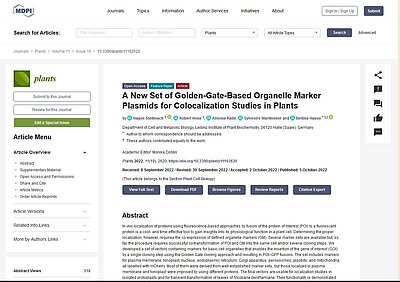Tracking proteins in the cell: New vectors for localization.
Precisely locating proteins of interest (POIs) in the cell is often essential to elucidate their physiological function. The most common in vivo localization method uses attachment of the POI to fluorescent markers, followed by transformation of the resulting fusion construct into the cells where it will be expressed. For precise localization of the POI in specific cell compartments, a suitable organelle marker has to be co-transformed. Because of low transformation rates, the co-transformation of two different vectors into the same cell can be a major hurdle for a successful localization study. IPB scientists have now developed a Golden-Gate-compatible set of different transformation vectors that already contain the most important markers for all basic cell organelles. Using the Golden Gate method, the genes of interest can be inserted into these vectors in a single cloning step. Consequently, users can with just one transformation express the POI tagged with fluorescent GFP alongside the desired organelle markers. The available mCherry-fused organelle markers include structures of the plasma membrane, tonoplast, nucleus, endoplasmic reticulum, Golgi apparatus, peroxisomes, plastids, and mitochondria. Many of these marker sequences were derived from already established marker sets, others were improved and optimized by the Halle scientists by using different proteins. The vectors developed are suitable for localization studies in isolated protoplasts and for transient transformation of Nicotiana benthamiana leaves. Their functionality was demonstrated using two enzymes involved in the biosynthesis of jasmonic acid, revealing that the enzymes are found either in plastids or in peroxisomes.


